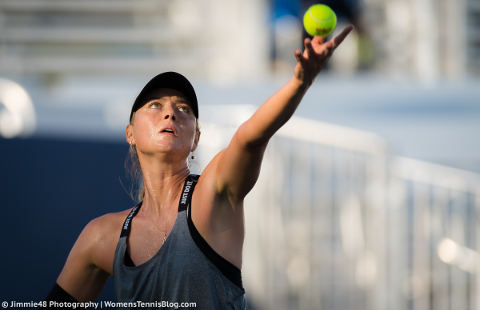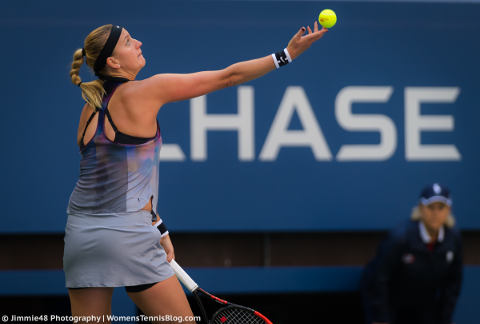After giving us tips on how to make our serve more effective, tennis coach Marcin Bieniek is giving us additional guidance on the proper ways to practice this important shot.

Which stroke is the most important in tennis? This is a challenging question because it depends on player’s skills. Rafael Nadal can praise his forehand. Serena Williams would say a lot about her returning skill. Petra Kvitova can’t see any more important stroke than serve. But should we always look at the most important stroke in tennis according to our strengths? I don’t think so. Serve is the one that we all should take a closer look at.
Serve is the area that is totally different than any other skill in tennis, as we have 100% control over our delivery. In other shots, we always have to react to the opponent’s intention — it doesn’t matter if we hit regular forehand or we have to chase the ball at the net, the rival dictates the point and we have to quickly adjust our movement and decision to answer this shot effectively. Serve is the only stroke that we don’t have to do that. We have 20 seconds before serving, so we can plan our actions in advance. Additionally, when we feel that something is wrong even after tossing the ball, we can stop the action and repeat it without losing the point. Knowing all the information, it is quite obvious that all players should focus on serve and make it as effective as possible.

I like to compare tennis serve to free kick in soccer. In soccer most of the situations are unpredictable, so players have to react to current situation. Free kick is a completely different story. The ball is stable on the ground, you can plan your action and there is no need for quick response. If you are good at it, you have a big chance to score the goal. The same approach has to be taken while serving in tennis. Of course, your goal is not always to hit an ace, but you have advantage in your hands, so you have to put pressure on your opponent.
From my coaching experience, I can say that too many players don’t put enough focus on serve and that is why they train this skill improperly. If you approach serve in the right way, you can get a lot of points during the match, so I believe it is necessary to understand these factors and implement them on a daily basis. There are many things that you can do to make your serve much better, so it only depends on how much effort you want to take. It doesn’t matter if you compete locally or you play international tournaments, because everywhere the rules are the same. To take your serve to the highest level you should:
PRACTICE ON YOUR OWN
There are many skills that require coach to be with you while practicing, but serve is not one of them. You can get on the court on your own and make many repetitions to get better with technique. Of course, you should first ask your coach what you should focus on, but after that all you need are reps. Take basket of balls and improve your serve on your own.

I like this Babolat Tennis Ball Cart because even when the balls are at the bottom you still don’t need to bend over to get them.
GET CONTROL OVER PLACEMENT
Placement is always more important than sheer power and this rule applies to serve as well. If you want to be able to use opponent’s weaknesses to win points, you have to be able to serve in this direction. Control of placement and direction can be easily trained while using targets. Place small cones in the service box and see how many times you can get close to your goal or even hit the cone.

I don’t like big cones because when you place them close to the line and you hit the top of it normally the ball would go out. It gives you false feedback. Pick flat ones like this Pacific X Disk Cone.
CONNECT SERVE WITH THE NEXT SHOT
Hitting the ball after serve is the most common situation where players make mistakes. There is less reaction as well, since players have to make really quick decision, so it is not surprising that many errors happen there. That is why if you want to cut down on this number, make sure you train in proper way. Try to serve and hit the next shot in the area that you want. The ball can be fed from your partner or you can throw it on your own if you are practicing solo. The more comfortable you get in this situation, the easier it will be for you to apply these skills while being under pressure.

There are also more advanced techniques and drills to make your serve better, but let’s start with these ones. Knowing the importance of serve in tennis, players have to change their approach to this area and start working consciously to make it their strength. As you can see from the examples above, there is no magic in this successful formula – all you need is some equipment and willingness to put effort to have solid delivery.
Marcin Bieniek is a professional tennis coach, currently working with a Top 60 ITF player, and founder of instructional website TennisIsland.us. Marcin is the author of Enjoy Tennis Blog and a frequent contributor to TennisPro and TenisKlub magazines. Moreover, Marcin was a speaker at International Coaching Tennis Symposium 2016 at Hilton Head Island, USA.
MORE ARTICLES BY TENNIS COACH MARCIN BIENIEK:
- Coaching tips: How to avoid mistakes in tennis
- Things to (not) do on vacation to improve your tennis game
- How to translate your tennis practice into match wins
- How to build team spirit in tennis
- How to become a master of claycourt tennis
- How to make your serve more effective
- How to choose the best tennis racquet to fit your level, playing style and body type
- How to handle playing tennis in sunny conditions and even take it to your advantage
- 5 portable fitness tools for serious tennis players
- Best foam roller exercises for tennis players





I always practice my serve using targets so I can check whether my serve is precise and accurate.
I was told by a tennis coach that serving is like poetry. I’m not sure I quite understood what he meant – any ideas?!
Helen – there are many comparisons in tennis jargon so it is hard to guess what your coach had on mind. If you have a chance ask for clarification to make sure that you understand it properly. In any communication understanding the context is crucial.